





As a founding employee of Gardener's Supply, I wore many different hats over the years. Currently, I have my own company called Johnnie Brook Creative. The gardens around my home in Richmond, VT, include a large vegetable garden, seasonal greenhouse, cutting garden, perennial gardens, rock garden, shade garden, berry plantings, lots of container plants and a meadow garden. There's no place I'd rather be than in the garden.
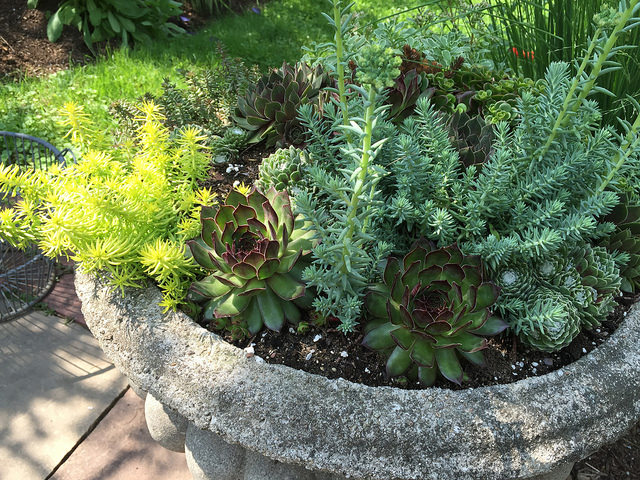
Hens-and-chicks (sempervivums) and sedum quickly fill the space in this concrete urn. Learn more about this planting was created in our blog.
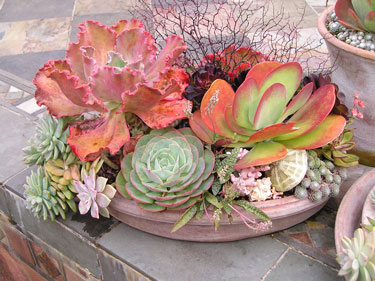
Succulents can be combined with shells, bits of glass and other objects to create fantastic container gardens.
FOR a great new look in container gardens, think succulents! These fleshy-leaved plants thrive in the simplest of pots and their distinctive shapes and colors provide endless opportunities for creativity.
The plants we refer to as succulents include sempervivums, sedums, aloes, kalanchoes, echeverias and other fleshy-leaved species. These plants have evolved in some of the toughest growing conditions on earth, and are actually at their best when grown in hot sun and poor soil.
Succulents lend themselves to all sorts of garden uses: in stone walls, between patio pavers, in rock gardens, and even for creating green roofs. But one of the easiest ways to grow them is in containers, specifically small dishes or troughs made from stone, terracotta, concrete or hypertufa.
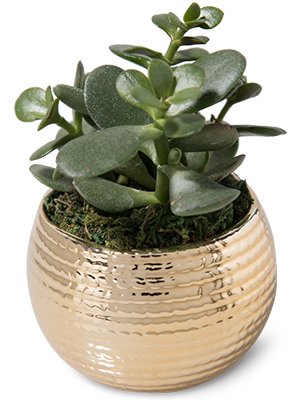
Gardeners in Britain have been growing plants in troughs since the early 1900s. As farmsteads were being abandoned for the city, farmers left behind beautiful hand-hewn stone livestock troughs. Gardeners were quick to realize that these troughs provided an ideal environment for growing alpine plants and succulents. Thus were the first container gardens born!
Today, authentic stone troughs are very difficult to find, and command prices of hundreds if not thousands of dollars. Ever resourceful gardeners have come up with a practical alternative: troughs, dishes and other small containers made from a mix of peat moss, perlite, Portland cement and reinforcing fibers. These materials are blended into a paste-like consistency which is then formed into a dish or trough and allowed to cure. The finished product, which goes by the name of "hypertufa," is much lighter than concrete or stone, yet has the same rustic character.
Hypertufa troughs and pots are quite readily available at local garden centers and online. You can also make your own hypertufa containers, which is a fun and relatively easy project. There are several books and many online articles that explain the process step-by-step.
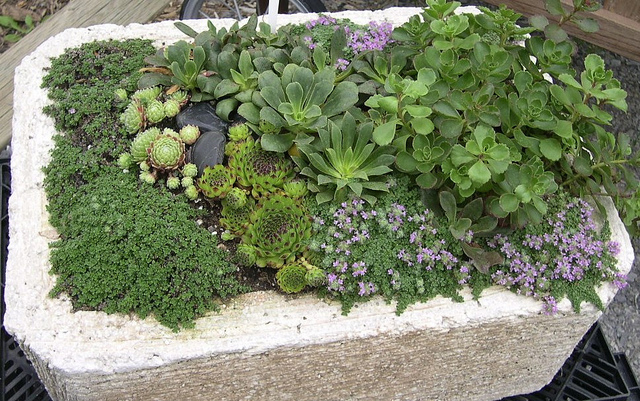
Hypertufa pots, planted with hardy perennials can be left outdoors year-round.
The planting medium in these containers should be well drained and not overly rich. For most succulents, add about 25% builder's sand to a good soilless mix. There's no need for fertilizer.
Now for the plants! Unless you garden in zone 8 or 9, you'll want to choose either sempervivums (also known commonly as hen and chicks) or sedums. Both are usually hardy to zone 4 or 5. There are hundreds of different sempervivums to choose from. A great thing about these plants is that they create miniature versions of themselves every year (these are the "chicks"). That's a good thing, because sempervivums hybridize with abandon and it's almost impossible to get them to come true from seed. This makes it difficult to keep the named varieties straight, but it also means that there's incredible variety in colors and forms.
There are two primary types of sempervivums. The first is Sempervivum tectorum, which is relatively large in size, fleshy and has a rather open face. The second type is Sempervivum arachnoideum, which is smaller, more rounded and ball-like, and has a silvery webbing over the leaves.
Some sempervivums are hardier and more stress-tolerant than others. If you start out with several different varieties, over time you'll probably arrive at a few favorites that are particularly well adapted to your growing conditions.
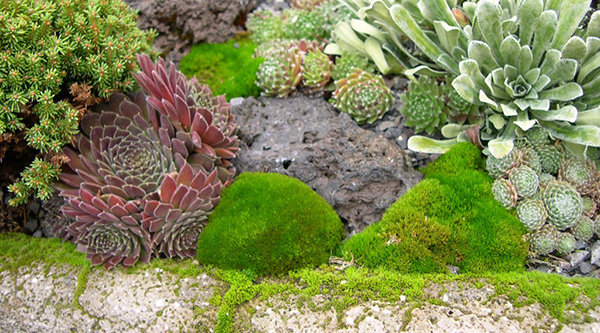
Detail of a planting in a hypertufa trough. Self-sown moss adds to the effect.
Sempervivums have a round and sculptural shape. Sedums make a nice complement as they usually have a finer texture and often add a cascading element to the composition in your container. There are many sedums that are hardy to zones 4 and 5, and others that are not. Heed the hardiness ratings, or be content with treating some of the more spectacular sedum varieties as annuals.
What else can you plant with your "semps" and sedums? This is where you can get really creative. Add rocks and shells, pieces of colored glass, small mirrors or sculptural features. You'll be amazed at what fantastic little worlds you can create inside your trough or dish garden.
Caring for your succulent garden is easy. Succulents aren't cactus, and they do require consistent moisture. They will be happiest in full sun, which also brings out the colors in their foliage. Hardy succulents can be overwintered right in their containers as long as the soil doesn't get soggy and they're protected from drying winds. Gardeners in zone 4 or colder may want to provide some additional protection from cold temperatures.
Once you get start growing sempervivums and sedums, you may want to branch out and experiment with some of the tender succulents, which include echeverias, aeoniums, pachyphytums and graptopetalums. These species have fantastic foliage and make great conversation pieces. If you live in a growing zone that's colder than zone 8, you will need to overwinter these plants indoors, or treat them as annuals.
Discover for yourself how fun it is to create an artful, easy care container garden using succulents.
Copyright © www.100flowers.win Botanic Garden All Rights Reserved